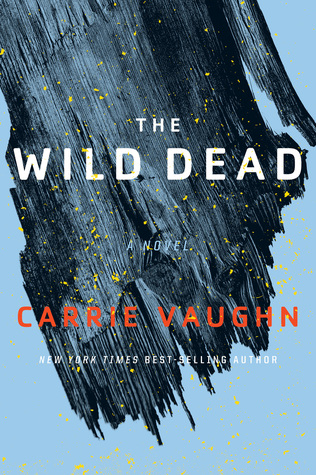The Wild Dead, by Carrie Vaughn,
near-future dystopian mystery
Summary:
Enid, an investigator in the Coast Road region, is called to settle a land dispute in a remote community called the Estuary. When she and her younger partner, Teeg, arrive, they are met with an easily-resolved dispute, barely-disguised resentments and old wounds . . . and a dead body. The victim is from the “outside”–one of the wild folk who live beyond the Coast Road’s strict laws–and it would be easy for Enid and Teeg to ignore the girl’s death. But though Enid is under time constraints, she won’t–she can’t–stop investigating. Even if it means leaving all that she knows to find the truth, a truth that the people of the Estuary don’t want revealed.
I’ll be honest: this is not my favorite genre. I can count the number of dystopian novels I’ve read on one hand, and that includes 1984, which I was forced to read in high school. (Gag.) But the premise of The Wild Dead was intriguing enough that I took a chance.
The book is the sequel to Bannerless, which I have not read, but you don’t have to have read the first book to enjoy The Wild Dead. I caught on to the premise of this near-future society fairly easily. Kudos to Vaughn for making it understandable; the society’s concerns are logical.
Here’s the basic gist:
After a man-made catastrophe, the world has few natural resources. (Wow, that might not be fantasy.) Survivors have created a system to sustain life without unduly burdening the remaining resources. People live in small households; there are quotas on food, material goods, etc. They must “earn” the right to have a child (signified by a banner) by proving that they can sustain and provide for themselves. All women have a birth control implant. It is only removed when their household earns a banner. To remove the implant is illegal.
(Side note: In every dystopian novel I’ve read, the society is absolutely obsessed with controlling women’s reproduction in some way.)
There are people who live outside of these communities, but they are the “wild” folk. Both the Coast Road population and the wild scavenging, barely-thriving populations are suspicious of one another and have little contact. (Funny how those two things seem to go together, isn’t it?)
What didn’t work for me:
1. The slow pace.
Granted, this isn’t a thriller. But it did move more slowly than I would have expected.
2. A fairly predictable plot twist.
I won’t spoil the twist. But I’m certain that almost anyone who’s read a lot of novels would see this coming. The characters might not, but I saw it coming from the very first mention of an important detail. That was page 15.
3. Certain idiosyncracies:
A minor quibble: Many of the characters say “Yeah?” as a throwaway word in their dialogue. As in, “You come tell us. Yeah?” It’s not actually a question. It’s rather like people punctuating their words with “you know?” It becomes annoying and undercuts the impact of the lines.
This is another minor quibble, but it’s one I’ve encountered in several books recently: There is more than one major character with a name starting with the same letter:
- Enid, Ella, Erik, El Juez.
- Juni, Jess.
- Teeg, Tom, Telman, Tomas (Enid’s late mentor, whom she recalls at several points in the narrative).
- There’s even an Anna and an Avery, though neither are major characters.
The names are almost all the same length, too. I don’t know how many other readers have this problem, but it can be too easy to misread names when they are similar lengths and start with the same letter. I realize that it’s hard to name a large cast of characters, but this is a little much.
What’s interesting is that, of all the characters, the ones in Enid’s household (Sam, Olive, Bertol) are the most vivid in my mind, even though they show up for less than two chapters’ worth of story. I suspect that the lack of E, J, or T names in the household helps!
What did work for me:
Okay, now for the positive things, and there are plenty of them.
1. Enid.
Let’s start with her. She won my heart from the first sentence of the entire book:
“Most regions Enid visited, she could find something to love about them, some enticing and beautiful detail about the landscape, the people, the mood of the place. A reason folk would want to stay and scrape out a living in less-than-ideal situations . . .” (The Wild Dead, pg. 1)
Immediately, I was drawn to her. She looks beneath the surface to find beauty where others might see only filth. She dives deeply to find others’ motivations. She’s willing to look at things that are hard to look at and see them with other people’s eyes. I like that characteristic.
It’s also refreshing to see a woman in the lead investigator role. She takes charge of situations and others (including older men!) obey her without hesitating or questioning her leadership. It’s refreshing that she is both strong and forceful and gentle and compassionate. Her kindness toward the mentally unstable Kellan is beautiful.
2. Vaughn makes the dystopian future setting easy to understand.
As I said earlier, this isn’t my favorite genre; I often struggle with understanding the whys/hows of dystopian societies, and I’m not a huge fan of elaborate world-building. But this was a setting that I understood. Part of the reason I didn’t struggle was because Vaughn does such a good job with showing real human relationships. Which leads me to point 3 . . .
3. The psychological and emotional truth in the relationships.
The conflict between Enid and her younger partner Teeg.
It’s a tale as old as the police procedural subgenre, but it’s true: the conflict between the young and the old(er) investigators about their roles, about how to investigate, about what they are searching for. The young mentee think she/he knows everything. The older mentor knows better but struggles to guide the headstrong younger person. (It’s also nice to see a female mentoring a male.)
Enid still misses her mentor, the experienced investigator Tomas, and grows frustrated with the young Teeg, who is brash, arrogant, and prone to jumping to conclusions. Their conflict about how to handle a murder “confession” (that possibly isn’t a confession) and how to handle the murder investigation rises from their characters. It also plays a huge role in their personal growth as investigators and people.
The insider/outsider dichotomy.
It’s human nature to point fingers, place blame, and try to divide people into “us” versus “them.”
- There’s a divide between the Coast Road people and the wild folk, but also . . .
- between those in the Estuary (where the murder takes place) and the rest of the more prosperous Coast Road towns, and also . . .
- between the people of “Last House” (the isolated household that has more contact with the wild folk than anyone else) and the rest of the Estuary, and also . . .
- the sense of being on the outside that Enid and Teeg experience as uniformed investigators. There’s plenty of finger-pointing and suspicions between all of these groups.
But then there are moments when Enid realizes that the people aren’t all that different.
She questions one nomad, a young man who admits to having known the dead girl: “It was funny. Some on the Coast Road said that the nomads–the wild folk, the ones who lived on the fringes–didn’t understand them, could never understand. Were uncivilized and not worth even speaking to. And yet, when this one said ‘Just friends,’ the words had exactly the same tone they did when anyone on the Coast Road said it in such circumstances, and Enid could guess the meaning well enough.” (The Wild Dead, pg. 132)
Both the insider/outsider dichotomy and the realization (small as it is) are well handled.
4. The strong ending.
It’s strong. I won’t spoil it. But it gave emotional closure both to Enid’s personal longings and her murder investigation. It also left the door open to sequels.
Overall, this was an enjoyable book. 4 stars.
As I don’t read much in this genre, I don’t have any similar titles to recommend. So, readers, help me out. What other dystopian mysteries have you read and enjoyed?

